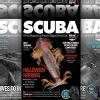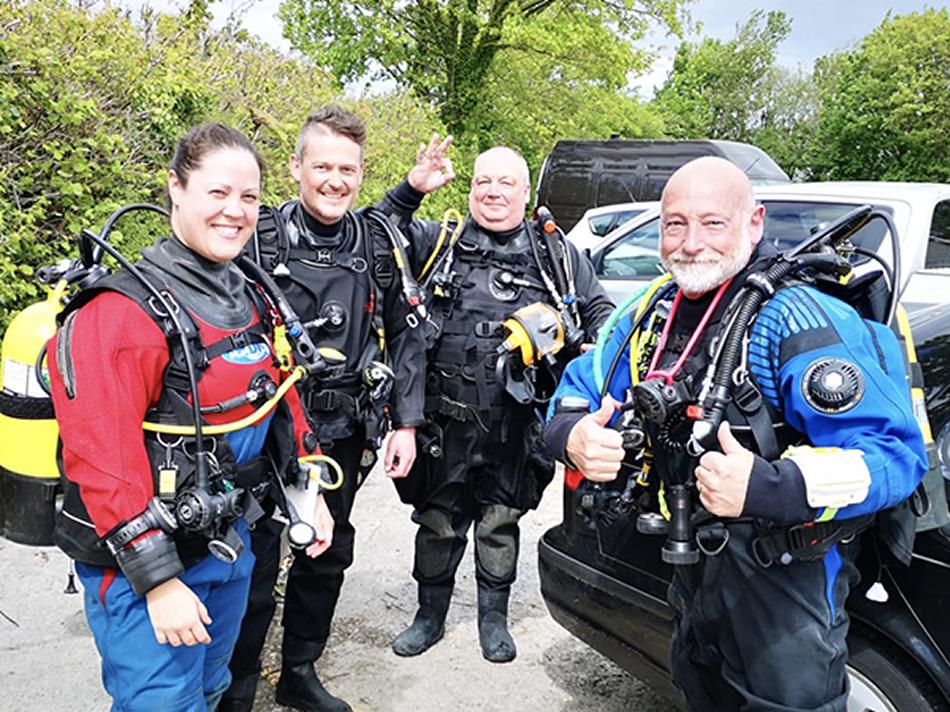
We all like the idea of protecting our seas, but what do the various designations really mean, and do they work? Bernadette Butfield presents a guide to Marine Protected Areas.
Home to a diverse array of species and habitats, the United Kingdom’s waters cover an area three times that of our land. As BSAC divers, we are undoubtedly aware of the many forms of marine life that call these waters home. From humpback whales and the largest bottlenose dolphins to endangered seahorses and basking sharks, the UK hosts many bucket-list-worthy species we divers dream of sighting.
Yet many of us will have witnessed first-hand a decline in marine biodiversity and habitat degradation over the years. As we continue to push the planet past its ability to resist climate change, it has never been more important to protect our marine environment – Marine Protected Areas (MPAs) offer a tool to do just that.
Navigating the topic of protected waters can be a complex task, with confusing terms and varying degrees of restrictions. This can often make it difficult to understand our role in marine protection as divers. Here, I aim to break down the MPA structure in the UK, which provides a beacon of hope for us to collectively understand how to restore our marine environment.
What is a Marine Protected Area?
In their simplest form, Marine Protected Areas (MPAs) are similar to terrestrial nature reserves and national parks. Areas of sea are designated to protect particular seascapes, habitats and species to help safeguard our ocean and make it more resilient to change.
In the UK we have a few types of designation available – this is where the complexity begins. Each of the devolved nations have the power to create MPAs to conserve nationally important species and habitats. These sites are also known as Marine Conservation Zones (MCZs) throughout England, Wales and Northern Ireland, and Nature Conservation MPAs in Scotland.
Ideally, the boundaries of an MPA should be placed around a diverse array of marine species and habitats, or areas of significant degradation. Protecting a wide range of marine environments improves biodiversity and can increase resilience to climatic changes and other anthropogenic pressures.
In the UK, important sites often include cold-water reefs, seagrass meadows, kelp forests, maerl beds and sandy or muddy sea floors.
Seagrass meadows in particular are known to capture carbon from the atmosphere up to 35 times faster than tropical rainforests, and support over 30 times more species compared to adjacent sandy habitats. Together, these sites form a mosaic of protected species and habitats, also referred to as an MPA network.
The goal is to develop an ecologically coherent MPA network that forms a ‘blue belt’ around the UK, providing protection to a wide variety of important marine environments and features.

A wall of anemones at the Isle of Man.
What is the point of Marine Protected Areas?
Well protected and managed Marine Protected Areas have been shown to increase the diversity of species and habitats, and even produce bigger fish within the boundaries.
The benefits created by MPAs are not limited to the boundaries assigned to them. As larvae drift along currents, the ‘spillover effect’ allows for an increase in species populations elsewhere. However, these benefits are reliant upon successful management and the development of an ecologically coherent corridor of protection.
What can you not do in a Marine Protected Area?
Within the boundaries of an MPA, restrictions are placed on certain damaging activities, often those destructive and extractive in nature, including fishing and construction.
The management measures of an MPA do not necessarily provide a blanket ban against all damaging activity to the marine environment. Indeed, many MPAs have been criticised for being nothing but ‘paper parks’. As many MPAs are designated to protect specific species and habitats, what is deemed ‘damaging activity’ can often vary between sites.
In some circumstances, damaging activity is clearly identifiable. Most notable is the act of scallop dredging with heavy bottom trawl fishing gear. This activity is known to cause destructive impacts to reef habitats and should be avoided at reef sites.
To achieve consistency, government bodies have developed guidance on which activities are considered to be damaging. This advice is then referred to regulators, who decide which management measures are most suited to a specific site. Generally, extractive, destructive and depositional activities (for example, fishing and construction) are considered to be damaging. Fortunately for us, scuba diving is often considered a low impact activity.
Lundy's Marine Protected Area
Smaller areas of varying protection can be designated within the boundaries of the MPA to prohibit certain activities and protect specific marine features. One example of such an MPA is the divers’ favourite, Lundy Island.
The Lundy MPA became the UK’s first MCZ in 2010, building on its existing status as a Special Area of Conservation in 2000. This well-loved site is home to a multitude of marine life, including grey seals and pink sea fans. Within the boundary of the Lundy MPA is a No Take Zone (NTZ) which prohibits extractive activity of any kind (for example, fishing). Anchorage and diver shot lines within 100m of the Knoll Pins are also prohibited.
Although the NTZ spans a modest four kilometres, many readers will have experienced the rich abundance of marine life the site offers, demonstrating the significant benefits of restricting destructive activities in a small area.
The need for greater protection
We have around 372 MPAs in UK waters, covering 38% of our territorial waters, but actual protection of marine species and habitats within these is highly variable. Surprisingly, fishing is allowed in most of the country’s MPAs and just 5% fully exclude all forms of bottom-towed fishing gear. Given the destructive nature of this activity, it could be said that only 5% of MPAs in the UK are in fact protected.
Indeed, not one offshore MPA (outside the 12 nautical mile limit) is protected from fishing of any kind. A recent study revealed that bottom trawling and dredging occurs in 98% of offshore MPAs around the UK. Protection within inshore waters (within the 12 nautical mile limit) is a little better, likely due to an eased ability to regulate and monitor activity.
Last year, the Benyon Review recommended the designation of Highly Protected Marine Areas (HPMAs). The independent review, led by Richard Benyon MP, considered an evidence-based process and selection criteria to identify potential sites for HMPAs.
These protected areas will be granted the 'whole-site' protection, prohibiting extractive and damaging activity taking place within the boundaries of the HPMAs, allowing nature an opportunity to recover properly. Such areas have been repeatedly proven to offer a ‘gold standard’ of protection to marine environments.
The Marine Conservation Society reports:
We have a network of 355 Marine Protected Areas in the UK, and whilst these lay the groundwork for better protections in the future, they don’t offer a full defence against all fishing and damaging activities. To get to this point we need Highly Protected Marine Areas.
The government’s 25-year environment plan and the Benyon Review both also mention the ‘whole-site approach’ to managing MPAs, whereby all damaging activity is prohibited from within MPA boundaries. Westminster government is calling for 30% of the world’s ocean to be protected in MPAs by 2030, with 10% fully protected, but before we start designating additional HPMAs, experts are calling for more restrictive measures to be adopted throughout our existing 372 MPAs.
Applying the recommendations of the Benyon review in existing MPAs will avoid the lengthy consultation process to identify and designate new sites. Designation is not enough, we need HPMAs with full protection to support the recovery of our marine ecosystems.
The Marine Conservation Society’s Principle Specialist in Marine Protected Areas, Dr Jean-Luc Solandt says:
The word ‘urgency’ is crucial here. While I welcome the recommendations of the report, the government must now act fast to implement them and be ambitious in its approach. We don’t need any more reviews – we now need urgent action.

Diving is considered a non-damaging activity.
Well managed and protected MPAs can act as a nature-based solution for ocean recovery, which is crucial in light of the current climate crisis and global pandemic. The Benyon Review drew on the successful NTZ at Lamlash Bay on the south-eastern coast of the Isle of Arran in the Firth of Clyde. This successful MPA demonstrates the power of local community campaign efforts to protect the treasures on their shores. Research from the University of York studying the site has documented a 50% increase in biodiversity.
Unlike many other MPAs, the NTZ at Lamlash Bay protects the wider environment rather than individual features, which underpins a ‘whole-site approach’ to protection, as recommended by the Benyon Review.
What we, as divers, can do for Marine Protected Areas
HPMAs could allow for areas to restore to a point where we can understand what a thriving seabed and marine environment truly means for the UK. They could set a baseline understanding from which other MPAs can be measured. In turn, this will help us to document what happens to our marine environments when damaging activities are removed entirely and help to determine appropriate management for the rest of the MPA network.
This is where our collective role as divers in the MPAs process is important. We are able to document the marine environment, providing valuable data regarding the species and habitat present at a site, and the damage and recovery first-hand.
A group of divers that have been working hard to provide such data is Seasearch. Seasearch aims to map out the marine habitats and the species that live in them throughout the British Isles. The data collected by Seasearch volunteers has supported the designation and continued management of MPAs throughout the UK.
The project is an excellent way for BSAC Sports Divers and above to develop their knowledge of the marine environment and to directly impact the future protection of the sites they know and love. More than 500,000 records of undersea species and habitats have been collected by volunteer Seasearch divers.
Get involved!
As scuba diving is considered a non-damaging activity, consider planning your next dive at your nearest MPA when we finally emerge from lockdown. Diving a Marine Protected Area not only provides a chance to explore thriving marine environments but supports the local livelihoods that benefit from the site through tourism.
While we need no excuse to kit up, you don’t have to head underwater to make a difference. Get involved in campaigns and consultations; perhaps contact your local MP to ask what they are doing to ensure the recovery of our oceans. We all need to collectively make Highly Marine Protected Areas throughout UK waters happen now.
Join the BSAC community
The BSAC network is working together to keep people connected to the sport. With online training, special interest webinars, competitions, support to clubs and the trade, and much more...we'd love you to join us.
This column article was originally published in SCUBA magazine, Issue #114 May 2021. For more membership benefits, visit bsac.com/benefits.
Images in this online version may have been substituted from the original images in SCUBA magazine due to usage rights.

 Author: SCUBA | Posted 14 Jul 2021
Author: SCUBA | Posted 14 Jul 2021



